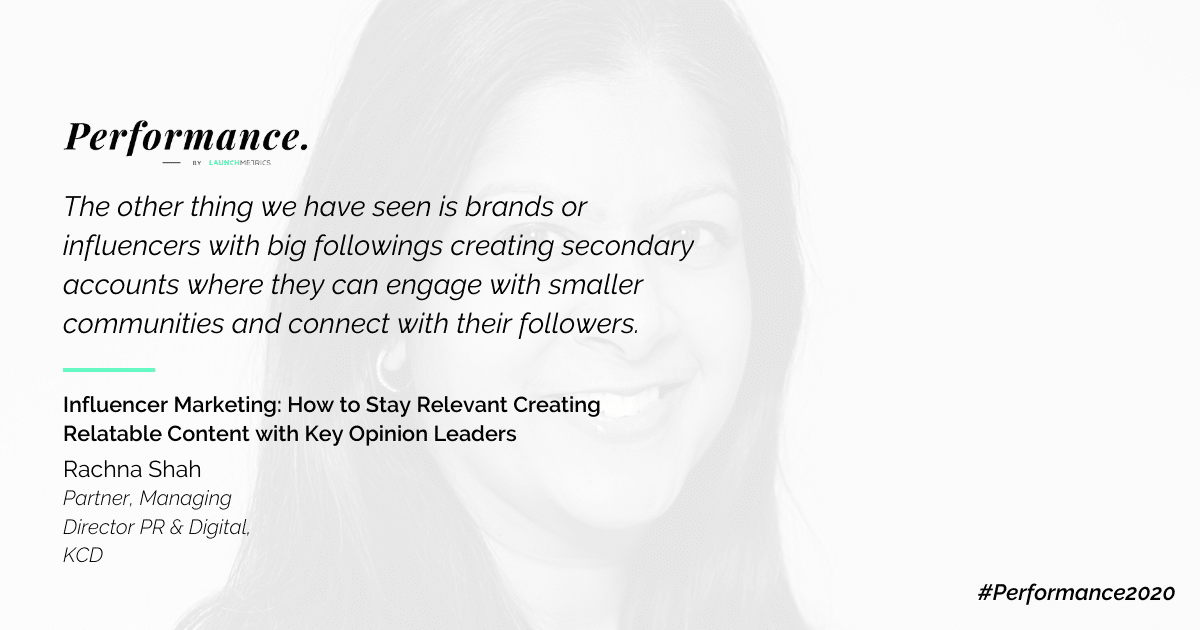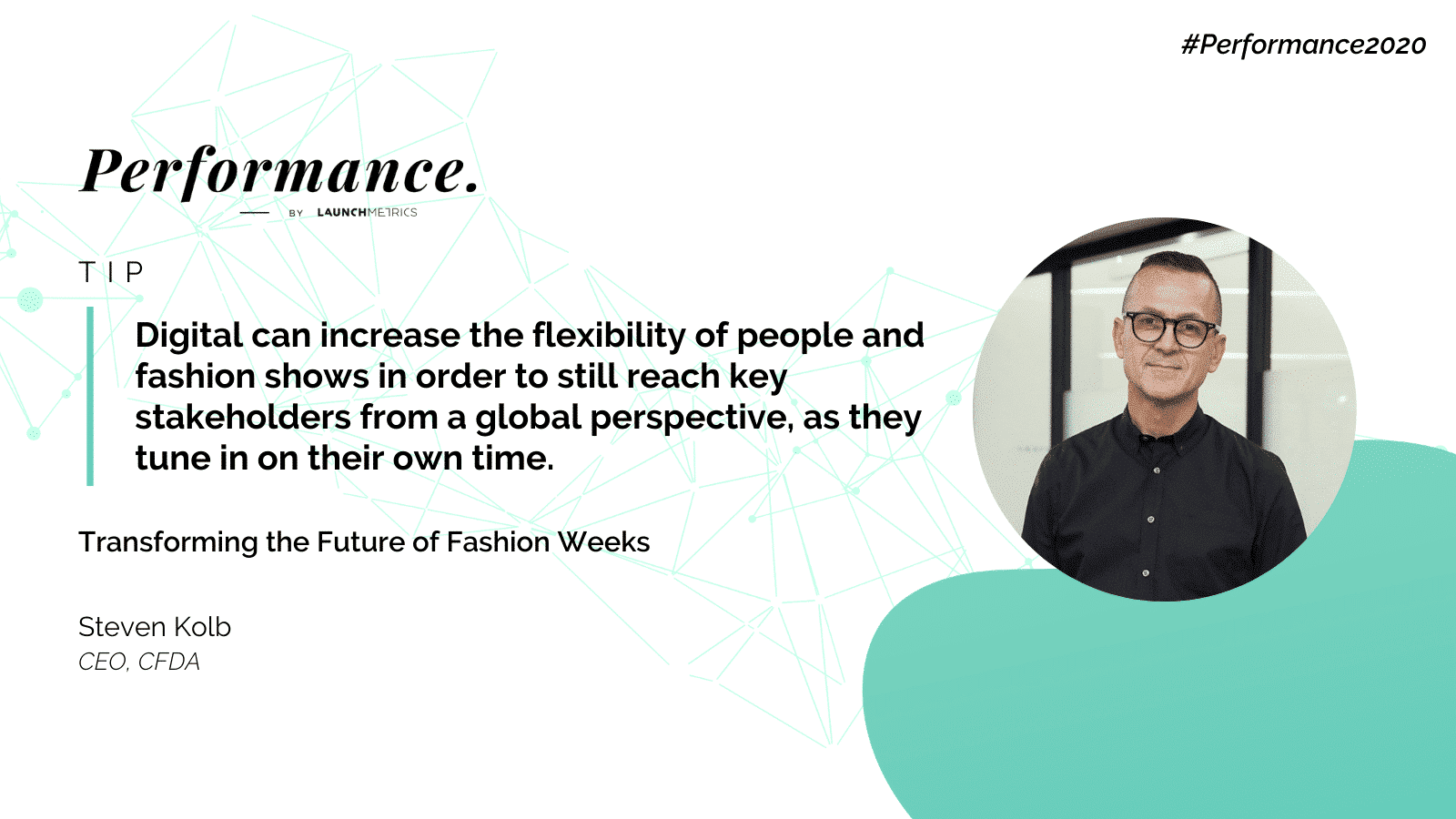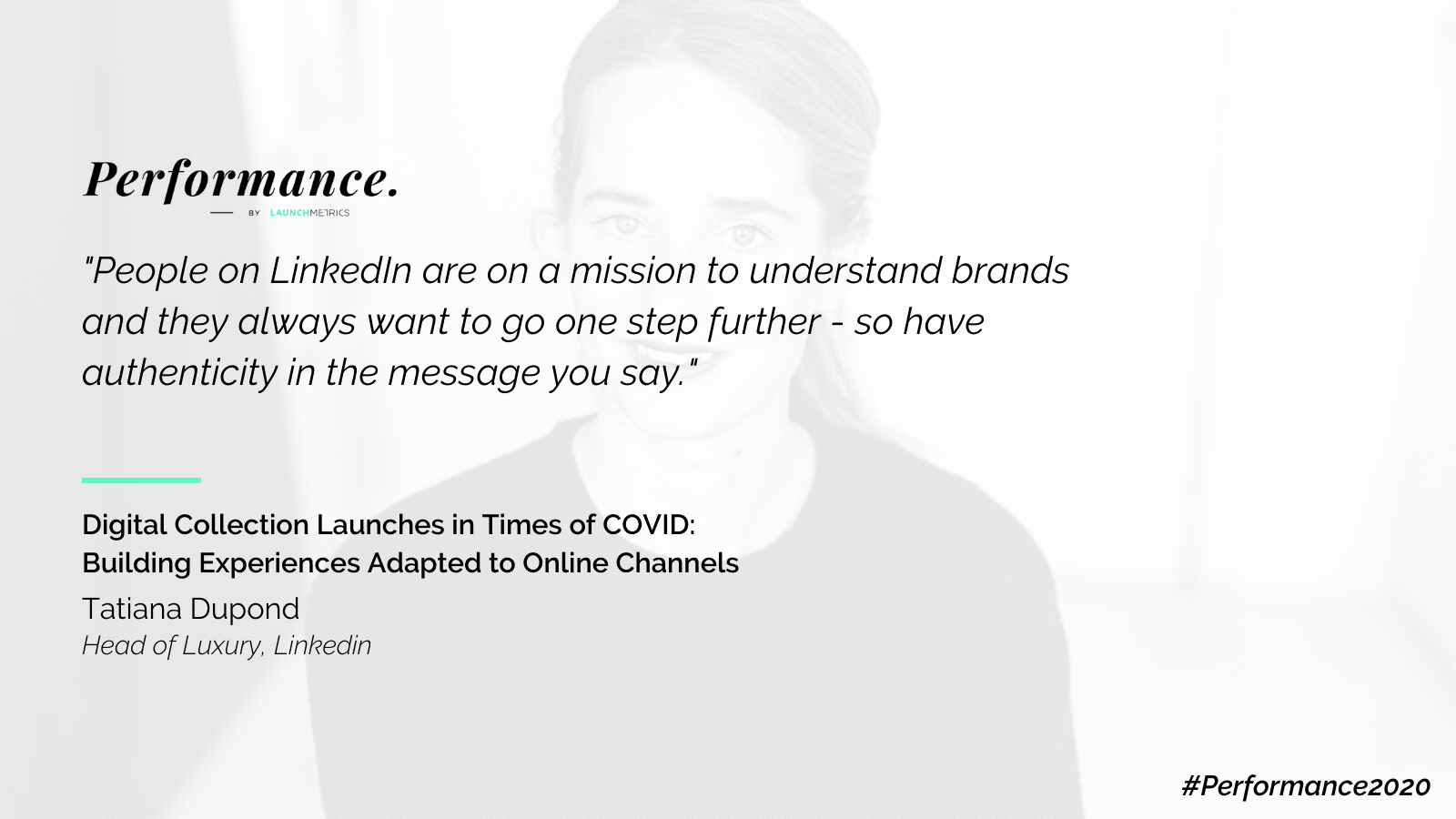On November 5th, Launchmetrics hosted the first digital industry summit on brand performance where individuals in the fashion, luxury, and beauty industries were able to connect and network with peers, as well as hear from 27 experts from leading brands and organizations to discuss the future of brand performance. Throughout the day, guests were able to tune in to listen to speakers from Allbirds, Anya Hindmarch, Breitling, British Fashion Council (BFC), Council of Fashion Designers of America (CFDA), Camera Nazionale della Moda Italiana (CNMI), Dior, Fédération de la Haute Couture et de la Mode (FHCM), Tatcha and many more.
As we wrap our digital summit and a full day of insightful discussions, in this article we summarize the 10 key takeaways from the Performance Summit by Launchmetrics.
“Brand Momentum = Investment/Impact” - Michael Jaïs, CEO, Launchmetrics
To kick-off the digital summit, Launchmetrics’ CEO, Michael Jais, paints the industry landscape with brands now facing challenges of the pandemic’s impact, the rapid digitization in the marketplace, as well a change in consumer demand. “In just the last five years, the number of touchpoints has been multiplied by three...it means that you have to work harder, move faster to keep the momentum, because momentum is the real asset, momentum is the real equity, ” states Jaïs. He continues to describe brand momentum as reducing cost while increasing a brand’s impact, mentioning how brands can stay agile by increasing their most valuable asset, which is brand equity itself. As such, brands need to adopt technology and intelligence and leverage data to identify opportunities across regions, across channels (online, social, print), and across Voices (media, influencers, celebrities, partners, owned media) to build brand momentum and drive performance.
"We've really changed how beauty has been portrayed, and there is going to be a lot more democratization of beauty going forward, which is positive for brands and consumers alike." - Antonia Baildam, Brand Partnerships Lead, TikTok
For the second session of the digital summit, Launchmetrics invited Tatcha Beauty, TikTok, Church & Dwight, and Glossy to discuss “The New Channels Reshaping the Beauty Industry”. Beauty consumers are now more empowered and more informed, and as such, information has become key. Michael Benson states, “Brands aren’t the authorities anymore. It’s been democratized. Consumers are looking less at brands. They are looking at social media, influencers, and more importantly at their peers and what their thoughts are.” As for the biggest disruptor for the industry, he advises for brands to look out for Amazon, who can provide an end-to-end experience to consumers which can significantly impact the way consumers shop. “The biggest disruptor is the evolving of these platforms to really fit with the times of today, like the increased screentime and how brands are making it convenient where consumers can shop directly or through live-selling,” states Rae Giron, Senior Manager, PR & Influencer Marketing of Tatcha, suggesting how brands need to experiment new formats to engage with consumers and accelerate sale cycles.
“Creators wanted to make useful content and there was an emerging sense of community and I’ve seen a lot more purpose with content - it’s inspiring, it’s educational, it’s helping people achieve something, try something.” - Reena Rai, Creator Content Lead, Pinterest
As the world entered lockdown and people navigated the “new normal”, consumers started looking towards useful and informative content, whether from traditional media sources or influencers, to keep them updated with COVID news, social issues, as well as help them adapt to the changing environment. “Beauty had proven to be a self-care method during quarantine that allowed many of our artists to show consumers how to use products and learn techniques at home,” mentions Candice O’Brien, Director of Talent Management of The Wall Group, showcasing how industry artists shifted their strategy and focused on investing their time and efforts in building a strong community during the pandemic. As brands look towards building influencer strategies, Rachna Shah, Partner and Managing Director of PR & Digital of KCD states “it’s so important to develop authentic voices and it’s obvious now when a brand is not being conscious, modern, and not understanding the community they cater to or who they are trying to attract.”

“The Chinese consumer has 8 touchpoints before that purchase intent which is double of what it is for Western consumers.” - Kim Leitzes, CEO, PARKLU
With the industry investing heavier into the Asia region, brands are discovering new opportunities and learning the differences in consumer behavior. Tina Ting, Marketing Director of Allbirds Asia joins Kim Leitzes, CEO of PARKLU to discuss the future of Asia. As to discuss why brands need to consider multiple platforms when engaging an Asian consumer, Ting states “there’s an interesting nuance as to why people go on to different platforms and it’s because they are looking for more information before making the final purchase - so the intent is already there which is why they are searching your brand - it’s very important for brands to have some information as customers are looking - it’s a crucial lower funnel touchpoint.” She further states that brands looking to grow and expand within China will need to localize and adjust the product and messaging eventually, encouraging brands to work with local agencies or invest in local human resources to navigate the multifaceted Chinese market such as the different tiered cities, the difference in consumer demands due to geographical locations, as well as meeting the changes within the market.
“The interaction at fashion week is so critical. It’s a cultural event and I don’t think we will ever leave those defined dates.” - Steven Kolb, CEO, CFDA
In a rare occurrence, the four leaders of the major fashion weeks and their associated institutions joined Jessica Michault, Executive Editor of ODDA Magazine, to discuss the future of fashion weeks and how these industry leaders are aiming to transform the fashion industry’s biggest event. On the topic of how the industry has benefited from digitization, “the community needs to have the chance to watch - which they haven’t before. It makes it more accessible and democratizes fashion.” states Carlo Capasa of President of CNMI. “It has been a fantastic field for innovation - something that would have taken 10 years has taken one, and there has been this incredible acceleration in order to serve and be helpful. I very much believe in democratization and diversity,” mentions Pascal Morand, Executive President of FHCM. However, in terms of whether or not digital shows will takeover physical events, Pascal disagrees, “but for sure, it has initiated what we can call a kind of augmented creativity. The relationship between fashion and the visual arts has been amplified,” he concluded.
As the industry works towards more inclusivity and diversity, Caroline Rush, CEO of BFC said “As that conversation has evolved, the whole conversation around diversity, inclusivity, to have gender-specific weeks in a way feels quite old-fashioned. The opportunity to have fashion weeks that are open to all genders, and much more inclusive in that respect, feels like the right way to go.” Capasa agreed, adding that “this gave much more democratization to fashion, in terms of audience but also in terms of brands who could participate, new designers, talent of color. We are starting a revolution in communication. What we did these last seasons is just the beginning.”

“It’s the obligation of the brand to understand the consumer and use the information they have available to personalize their engagement.” - Antonio Carreiro, Chief Digital and Technology Officer, Breitling
There is no surprise that the luxury consumer has changed and with more willing to spend their dollars items, luxury brands need to adapt to digital channels to drive sales revenue under the new normal. To discuss these changes in the luxury marketplace, Antonio Carreiro, Chief Digital and Technology Officer of Breitling joins Journalist Laurie Brookins to identify how brands can leverage online channels to connect with luxury consumers. “From a brand perspective I think consistency is really important, it’s not about dropping from one touchpoint to another but staying consistent with messaging and communication,” states Carreiro, suggesting that digital touchpoints are important in the consumers’ decision-making process. “We are in the business of emotions,” Carriero said, mentioning that watch purchases can be both an emotional and impulsive experience further stating that the sales cycle can be around 3-4 months, which is why luxury brands need to build consistent and personal touchpoints to engage consumers during the purchase decision process.
“Brands need to invest in brand building and building that emotional connection with their consumer, because that is what will create a lingering impact after the pandemic and build brand performance.” - Alison Bringé, CMO, Launchmetrics
While most of the world is still navigating the impacts of the pandemic and businesses are becoming savvier of the changes within the industry and how to adopt, Alison Bringe, CMO of Launchmetrics shares a keynote on how brands can stand out within the market during this time. “There are a lot of silver linings out there for marketers - one of which is that there have been years of digital transformation take place in just months,” she mentions, further stating that brands need to find the right balance between targeting the new and the old customer in order to be successful. “Digitization impacts older customers too. There has been a 42% increase in social media consumption by baby boomers and Gen X,” she states and while marketing spends will increase in 2021, “ROI and efficiency are going to be the most important thing when you look at which strategies to explore and where to direct your marketing budget,” she adds.
“For us, being a luxury brand, creativity will always lead and we value the creative aspect first and foremost - we decide on platforms, influencers paid strategy - everything is driven by creativity and innovation.” - Gary Pinagot, Social Media and e-Reputation Director, Dior
To discuss how brands can build a successful collection launch in times of COVID, Launchmetrics’ Chief Customer Officer, Tatiana Ferreira, meets with Gary Pinagot, Social Media and e-Reputation Director of Dior and Tatiana Dupond, Head of Luxury of Linkedin. “Today’s luxury buyer buys more than just the clothes, they buy what is behind the brand and what the brand values are,” said Dupond, proposing that brands need to build a comprehensive content story to communicate its story and deliver the brand’s purpose. In terms of building strategies for collection launches, Pinagot suggests brands to find the right balance between leveraging data, protecting the collection’s message, and finding the right platforms to deliver the message.

“People on Linkedin are on a mission to understand brands and they always want to go one step further, so have authenticity in the message you say,” Dupond mentions, further stating that brands have been seeing very strong results and engagement through launching on Linkedin Live. “Louis Vuitton did four of their last shows live on Linkedin and they have a whole strategy around it - they reached 3 million unique luxury buyers on Linkedin so it's a great asset for luxury and fashion brands,” she shared, showcasing the opportunities for brands to explore niche and targeted platforms when it comes to strategizing for collection launches.
“What has been refreshing is that the last 8 months we have been as busy as ever because a lot of brands that we never expected are saying that they are interested, not just talking about sustainability but being sustainable.”- Diana Verde Nieto, Cofounder, Positive Luxury
Sustainability has been a heavily discussed topic within the fashion, luxury, and beauty industry and with the pandemic serving as a catalyst and a wake-up call for many, sustainability became a bigger part of the consumer decision-making process. For the last session of the Performance Summit, Launchmetrics invited Journalist, Dana Thomas, Diana Verde Nieto, Cofounder of Positive Luxury, Anya Hindmarch, Founder of her namesake brand, Anya Hindmarch, and Nicolaj Reffstrup, Cofounder of Ganni to discuss how brands can rebuild a more sustainable industry.
"Economically, financially - we tried to ensure the products we launched didn’t end up as marketing gimmicks but also that we can implement it in the overall merchandise floor or else otherwise, it won’t have a real impact, it will just be storytelling," mentions Reffstrup, proposing brands to ensure that any sustainable collection launches should have a lasting impact and should shift away from a storytelling mindset. "When we throw something away, there's no away," says Hindmarch, reminding us of the environmental impact the fashion, luxury, and beauty industry brings.
As the year comes to an end, our industry continues to navigate behavior changes and explore new strategies to engage with consumers under a rapidly evolving environment. For many brands within the fashion, luxury, and beauty industry, 2021 will be a critical year. Launchmetrics' CMO, Alison Bringe, mentions digital marketing spend by 2021 will be at $120B, measurement will extremely key for brands to understand their ROI and have insights into where investments should be made. We hope you enjoyed our Performance summit by Launchmetrics and if you missed it, you can access all of the digital sessions on replay, here!
